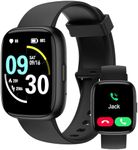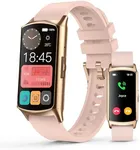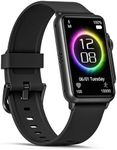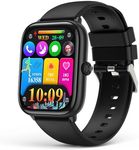Buying Guide for the Best Smartwatch For Seniors
Choosing a smartwatch for seniors is all about finding a device that is easy to use, comfortable to wear, and packed with features that genuinely support daily life and well-being. Seniors often benefit from smartwatches that prioritize health monitoring, clear displays, and simple navigation. When shopping, focus on how the watch will fit into the user's lifestyle—whether it's for health tracking, staying connected with family, or simply telling the time. Always consider the user's comfort with technology and any specific needs, such as medical conditions or visual impairments.Display Size and ClarityThe display is the screen where all information is shown. For seniors, a larger and brighter display with high contrast is important because it makes reading notifications, time, and health data much easier. Displays can range from small, compact screens to larger, more readable ones. If the user has vision difficulties, opt for a bigger, high-contrast display. If portability and a lightweight feel are more important, a smaller screen might be fine, but always ensure it's still easy to read.
Ease of UseEase of use refers to how simple it is to navigate the watch's menus and features. Some smartwatches have touchscreens, while others use physical buttons. For seniors, a straightforward interface with large icons and minimal steps to access key features is best. If the user is not very tech-savvy, look for watches with simplified menus or even special modes designed for seniors. Trying out the interface in-store or watching demonstration videos can help determine if it's a good fit.
Health Monitoring FeaturesHealth monitoring features include things like heart rate tracking, fall detection, emergency SOS, and step counting. These features are important for seniors because they can help track health trends and provide peace of mind for both the user and their loved ones. Some watches offer basic tracking, while others include advanced features like ECG or blood oxygen monitoring. Choose the features that match the user's health needs—if they have heart concerns, for example, a watch with heart rate alerts or ECG might be valuable.
Battery LifeBattery life is how long the watch can operate before needing to be recharged. Some smartwatches last only a day or two, while others can go a week or more on a single charge. For seniors, longer battery life is often better, as it reduces the need to remember to charge the device frequently. If the user is likely to forget to charge the watch, look for models with extended battery life or power-saving modes.
Comfort and FitComfort and fit refer to how the watch feels on the wrist. Seniors may have sensitive skin or joint issues, so a lightweight watch with a soft, adjustable band is ideal. Bands come in different materials like silicone, leather, or fabric. If possible, try on different styles to see what feels best. A comfortable watch is more likely to be worn regularly, which is important for both health tracking and safety features.
Water ResistanceWater resistance means the watch can handle exposure to water, such as hand washing, rain, or even swimming. This is important for seniors who may forget to take off their watch before getting wet. Water resistance is usually rated in meters or as 'splash-proof.' For everyday use, a basic level of water resistance is usually enough, but if the user swims or showers with the watch, look for higher ratings.
Connectivity and CompatibilityConnectivity refers to how the watch connects to other devices, like smartphones, and whether it can make calls or send messages on its own. Compatibility means whether the watch works with the user's phone (Android or iPhone). Some watches require a smartphone for full functionality, while others can operate independently with their own SIM card. Make sure the watch is compatible with the user's phone and consider if features like call alerts or text messages are important for staying connected.
![Apple Watch Series 9 [GPS 41mm] Sma](https://images-proxy.bestreviews.guide/uJw6WEAn0fS5tEAccyZhGLuea08=/0x150/https://m.media-amazon.com/images/I/41NHOwYXLnL._AC_CX679_.jpg)







![Apple Watch SE (2nd Gen) [GPS 44mm]](https://images-proxy.bestreviews.guide/mWlmkgLLy6tB_m_YU212hY3bAS0=/0x150/https://m.media-amazon.com/images/I/3156Ea-lIML._AC_CX679_.jpg)







